THE Thompsons’ Holstein dairy herd is housed in a large free-stall barn where the cows face a central feed lane and can lie down on sand bedding between milkings.
Dairy farmers Colin and Erina Thompson have spent the past two decades radically changing their business. In the process, they have moved nearly 400km from their coastal base at Narooma, South East NSW, to Cowra in the Central Tablelands.
“We knew our operation was not going to be viable on the coast and we looked for somewhere that could offer us the chance to expand.”
READ MORE - Farming innovation
- Biofuels: Australian farmers’ untapped resource
- Maggots: The livestock feed no-one saw coming
But the physical move was probably the least of the changes as they moved from a grass-based dairy farm to a free-stall barn enterprise with 320 Holstein cows, and most of their replacement heifers, housed in a barn full time.
The impetus for the dramatic change was the deregulation of the NSW dairy industry in 2000, when the Thompsons realised their 70-cow Narooma operation would not survive in a deregulated market. “We knew our operation was not going to be viable on the coast and we looked for somewhere that could offer us the chance to expand,” Colin says.
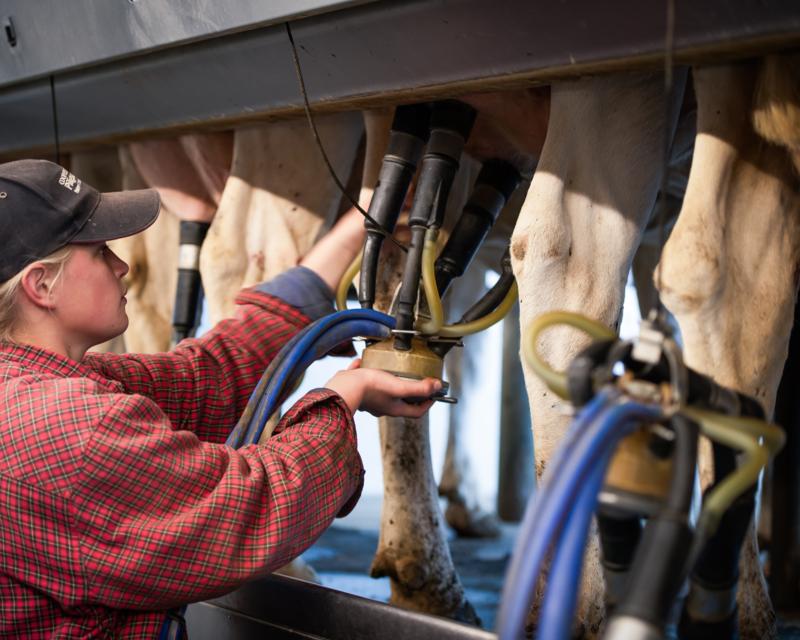
Colin’s niece, Aloah, helps milk the cows; sand bedding in every stall ensures a clean and comfortable place for the cows to lie down; a young animal in one of the dedicated calf-rearing facilities.
The search led them to the Cowra district which had a number of attractions, primarily secure irrigation water and the ability to grow plenty of feed. The climate was also a factor, with relatively mild summers and only a few hot days, along with cool, but not cold, winters. Low humidity was also a plus compared to coastal areas.
Cowra’s proximity to supplies of grain, fodder and concentrates was another advantage for the establishment of a free-stall barn where cows are fed a total mixed ration each day.
The Thompsons bought two farms to set up their dairy enterprise, Silvermere Holsteins, deliberately choosing properties that had not previously been used for dairy farming. “I really did want a greenfield site so we could develop the operation the way we wanted to,” Colin says.
Overhead fans, which automatically speed up as the temperature rises, ensure optimum airflow throughout the free-stall barn. Additional cooling is provided by a fine water misting system.
They chose a 114-hectare block on higher ground to build the free-stall barn and a 12-a-side parallel rapid exit dairy, selected for its efficiency and safety aspects. Their second block, 100ha of alluvial Lachlan River flats subject to flooding, is used to grow crops.
More recently, they bought a 146ha property to produce fodder to back up supplies for their own dairy and also supply high-quality lucerne to a chaff mill.
Colin says their complex business model centres around cow comfort, feed quality and good working conditions, which a free-stall system helps to achieve.
The cows are housed in a 102m by 55m barn where each cow has a stall to rest in between milking, which is done three times a day, at 5am, 1pm and 8pm. The stalls are designed so the cows face inwards to a central feed lane.
Manure and urine drop into a lane behind them, keeping the sand bedding, and the cows, clean. Sand provides comfortable and inorganic bedding for the cows.
RELATED: Riverina pig farmer transforms waste into electricity
Fans ensure good airflow. As the temperature rises, the fan speed automatically increases and additional cooling is provided by fine water mist when required. The cows are fed a mix of fine chop corn silage, lucerne silage, grain, protein meals, cottonseed and mineral supplements.
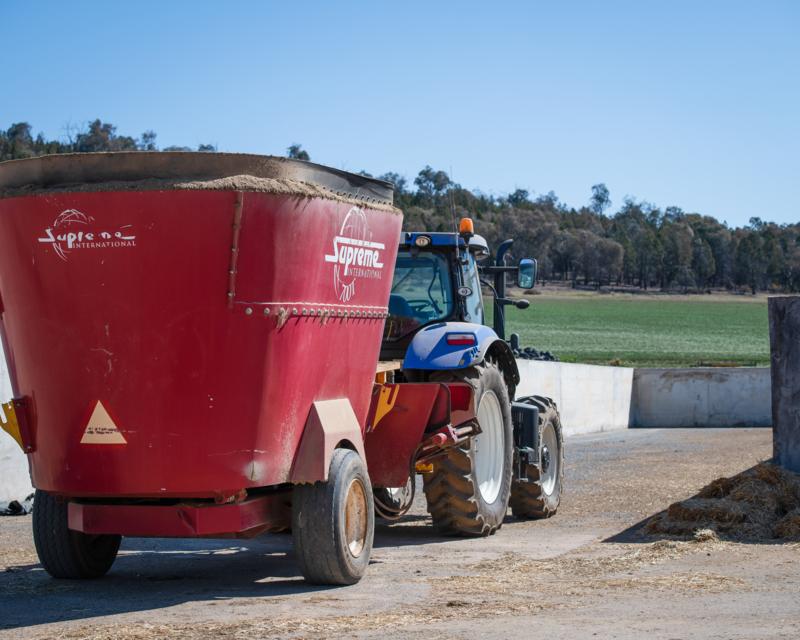 Three loads of feed are mixed each morning and distributed by a feed mixer wagon along the central feed lane, which the cows can reach into from their stalls.
Three loads of feed are mixed each morning and distributed by a feed mixer wagon along the central feed lane, which the cows can reach into from their stalls.
Colin says it’s a 4am start for the person assigned to feeding and their first job is to clean out any feed left over from the day before. This is recycled into a ration for the heifers.
“There is nothing wrong with that feed and we like to provide more than we know the cows can eat,” he says.
The shed is divided into a number of areas to allow for different management and rations for different groups of cows: the milking herd, dry cows, pregnant heifers and transition cows (pregnant cows in the final three weeks of gestation). There is also a hospital pen for cows on treatment or needing special attention.
When calving is imminent, cows are put in separate pens so they can calve by themselves or be assisted if necessary. As soon as a cow calves, her colostrum (the milk that contains antibodies to protect the calf) is collected and fed to the calf. The cow is then taken to another area and monitored for two weeks before being returned to the milking herd.
INVESTMENT IDEAS - MAXIMISING RESOURCES FOR EFFICIENCY
Colin says he gained most of the information on how to establish his dairy from the United States, where most dairy farms employ a similar system.
The shed is divided into a number of areas to allow for mixed management of different groups of cows: milking, dry, pregnant and transition (pregnant in final three weeks of gestation)
Herd health is vital in the intensive system and a veterinary team from the University of Sydney visits the farm every two weeks to monitor and produce monthly reports on reproduction and herd health. They also do ultrasound pregnancy testing and condition score the cows.
“It is about maximising efficiency in terms of utilising the resources of land, water and cows to make the most of our investment,” he says.
“Basically, we have developed a high-production cropping and storage program that provides a reliable source of high-quality feeds for the dairy.”
Animal health checks and management take place in the barn. Every morning after the first milking, the headlocks in the stalls can be set to secure the cows as they are eating. This allows the farmer to check if animals are in heat, and artificially inseminate, pregnancy test and vaccinate cows as required, without the stress of drafting or having cows away from feed.
Improved foot health has been another benefit of the free-stall barn system, Colin says. Each cow has its feet trimmed twice a year and can lie down at any time, which he believes is a big help. “Cows are not designed to stand around on concrete for hours and this can really affect their general health,” Colin says.
Heifer and bull calves are raised in their own facilities. While the heifers go on to join the dairy herd, the bull calves are grown out to approximately 300kg and sold under contract at seven months.
RELATED ARTICLES: Beef and cattle
- From paddock to Asia, the brand smashing the supply chain
- Secret to success: 160 years of farming with Booroomooka Beef
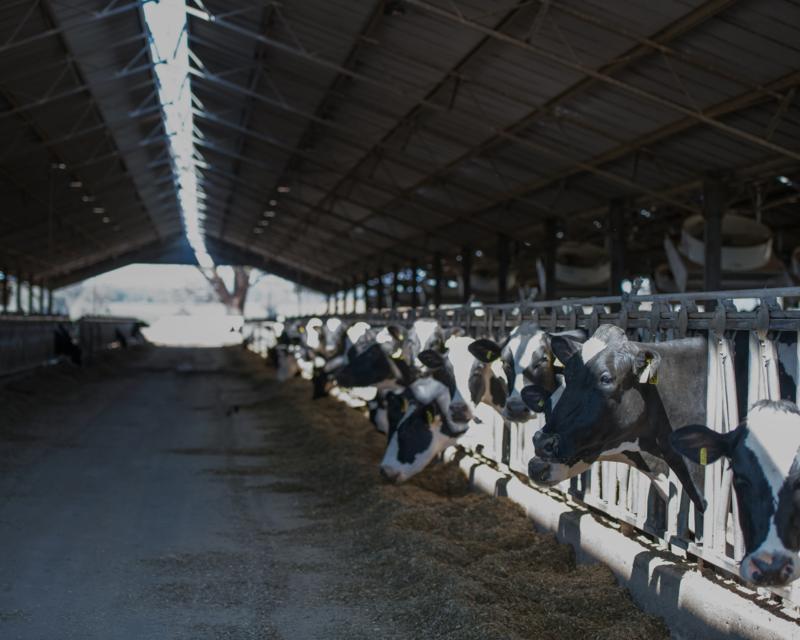 The Thompson’s Holstein herd is registered through Holstein Australia, which Colin says involves minimal extra work.
The Thompson’s Holstein herd is registered through Holstein Australia, which Colin says involves minimal extra work.
“Having a registered herd (or a stud herd) adds value to our cows,” he says. “The breeding and genetics of our cows is a pretty important part of our business. We use the best genetics we can and we correctively mate to always ensure we are trying to breed the right kind of cows.”
To this end, the Thompsons use a couple of semen companies but focus much of their buying and attention with Canadian-based Semex. “We have a consultant who comes in and helps us with bull selection,” Colin says. “He assesses each cow and then makes an individual sire recommendation for each one.”
INNOVATION - THE FREE-STALL BARN SYSTEM
It’s taken a number of years for the Thompsons to develop their free-stall barn system and Colin says they are close to where they would like it to be. “We have eight permanent staff who have different responsibilities but work together to ensure the smooth running of the dairy, 365 days of the year,” he says.
Their farms have a combined water allocation of 600 megalitres of high security water, 600 megalitres of general security water (both from the Lachlan River) and 400 megalitres of bore water. This enables them to grow approximately 3,000 tonnes of corn silage, 2,500 tonnes of lucerne silage and 1,200 tonnes of cereal silage.
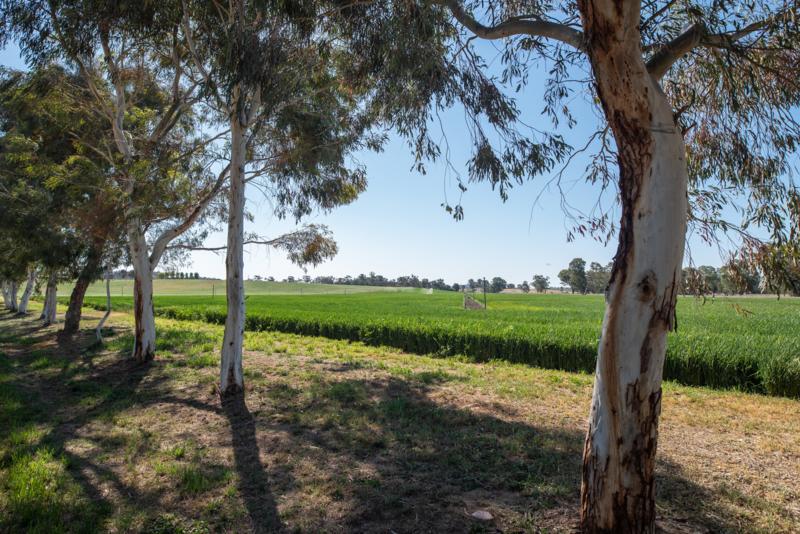
Growing high-quality feed and then being able to store it to maintain its quality are key factors to the success of the Thompsons’ dairy operation.
Colin says the mix of corn and lucerne is ideal as a dairy ration, with the corn providing high levels of energy and digestible fibre. Corn silage tests regularly show a metabolisable energy (estimated energy available to the animal) of 11.5 megajoules/kg of dry matter with starch levels of about 30-35%, while the lucerne silage provides energy and about 24% protein.
While the Thompsons initially felt the two properties they bought were enough to supply their needs, they bought another property five years ago to provide extra feed security. In most years, this generates about 1,500 tonnes of lucerne hay, which they sell. They also grow wheat, lupins and canola as rotation crops to use in the dairy.
The silage is stored in concrete bunkers to ensure its quality is maintained and to minimise losses, and all silage is feed-tested monthly to monitor quality.
It goes without saying that a free-stall barn enterprise needs a good recycling system. This includes the cleaning and reusing of bedding sand, and an extensive effluent management system.
“Good feed hygiene is essential for high intakes and milk production, so we ensure that no spoilt or mouldy feed gets into the ration,” Colin says.
HOW THE EFFLUENT MANAGEMENT SYSTEM WORKS
- Each cow lane is flushed three times a day to remove effluent and sand.
- The sand is separated from the effluent using sand settling lanes. It is then washed clean, dried and reused as bedding for the stalls.
- The manure and water are collected in a tank and put through an effluent separator to remove the fibrous material. About 60 tonnes of this is collected each week, formed into rows and turned, to eventually make compost that is spread on the paddocks.
- The remaining liquid then goes into the first of three settling ponds. The initial pond collects a sludge-like material which is pumped out twice a year into a tanker and spread across paddocks as fertiliser.
- The second and third ponds are essentially green water which is free of solid material and is used for flushing the barn and to irrigate crops. Some of the irrigation systems, including fixed sprinklers, can handle the recycled water, which has some particles in it. The pivot irrigator, which waters two 37ha circles, only utilises fresh irrigation water.
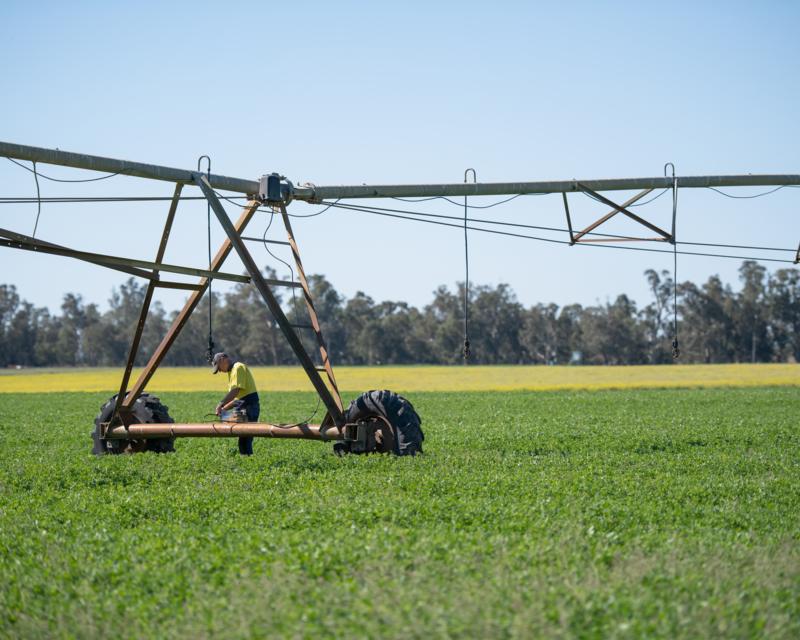
The farm uses a combination of fresh and recycled water to irrigate crops. Here, Colin sets up a pivot irrigator in a field of lucerne.
“We are able to recycle the water we use for the barn to irrigate crops, and that water has the benefit of nutrients which are added in,” Colin says. “We do lose some water, of course, but the amount is really negligible.”
THE SUPERMARKET DAIRY WARS
Supermarkets must end the milk wars if they are serious about helping out dairy farmers – that’s the battle cry of NSW Farmers.
In September, Coles and Woolworths both announced 10c per litre levies on certain own-brand milk products, with the extra going to help farmers in drought. But NSW Farmers’ Dairy Committee chair Erika Chesworth says the levy is not a long-term solution to the dairy crisis, and is urging the supermarkets to pay farmers what they deserve.
“Farmers need fair prices in both good and bad years to ensure they have good business resilience and that we have a sustainable dairy industry,” Erika says.
“Dairy farmers are doing it tough at the moment and the big supermarkets must show leadership to ensure farmers receive fair prices and the industry is sustainable, but their response has just been a marketing ploy."
“We have grave concerns that dairy farmers will not actually receive any benefits from the announced price increases.
“Farmers know the proposed drought relief range will divert sales away from branded products and are very concerned about it further diminishing the value within the dairy supply chain. There is no guarantee it will go to dairy farmers as it is flowing through drought relief funds.”
DROUGHT RELATED ARTICLES:
-
The drought hay crisis
-
Livestock to hay production: Tamworth farmer diversifies during drought
-
Donated hay survey: where drought-affected farmers found relief
-
26-year-old silage offers drought relief for Tamworth farmer